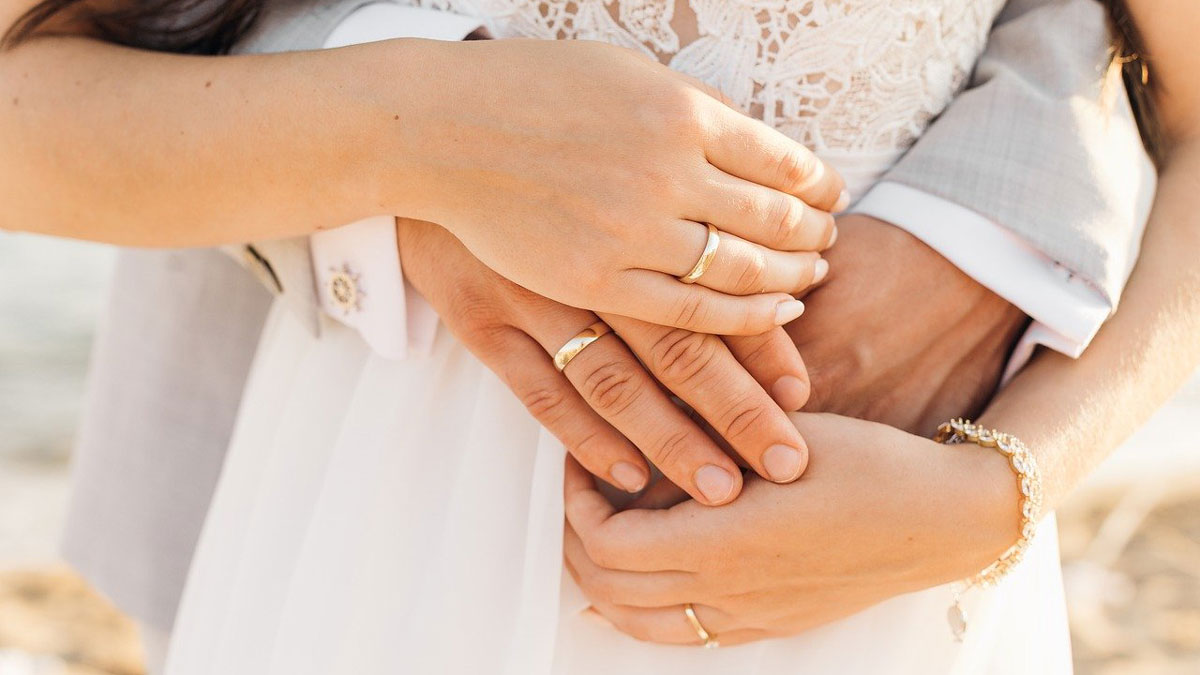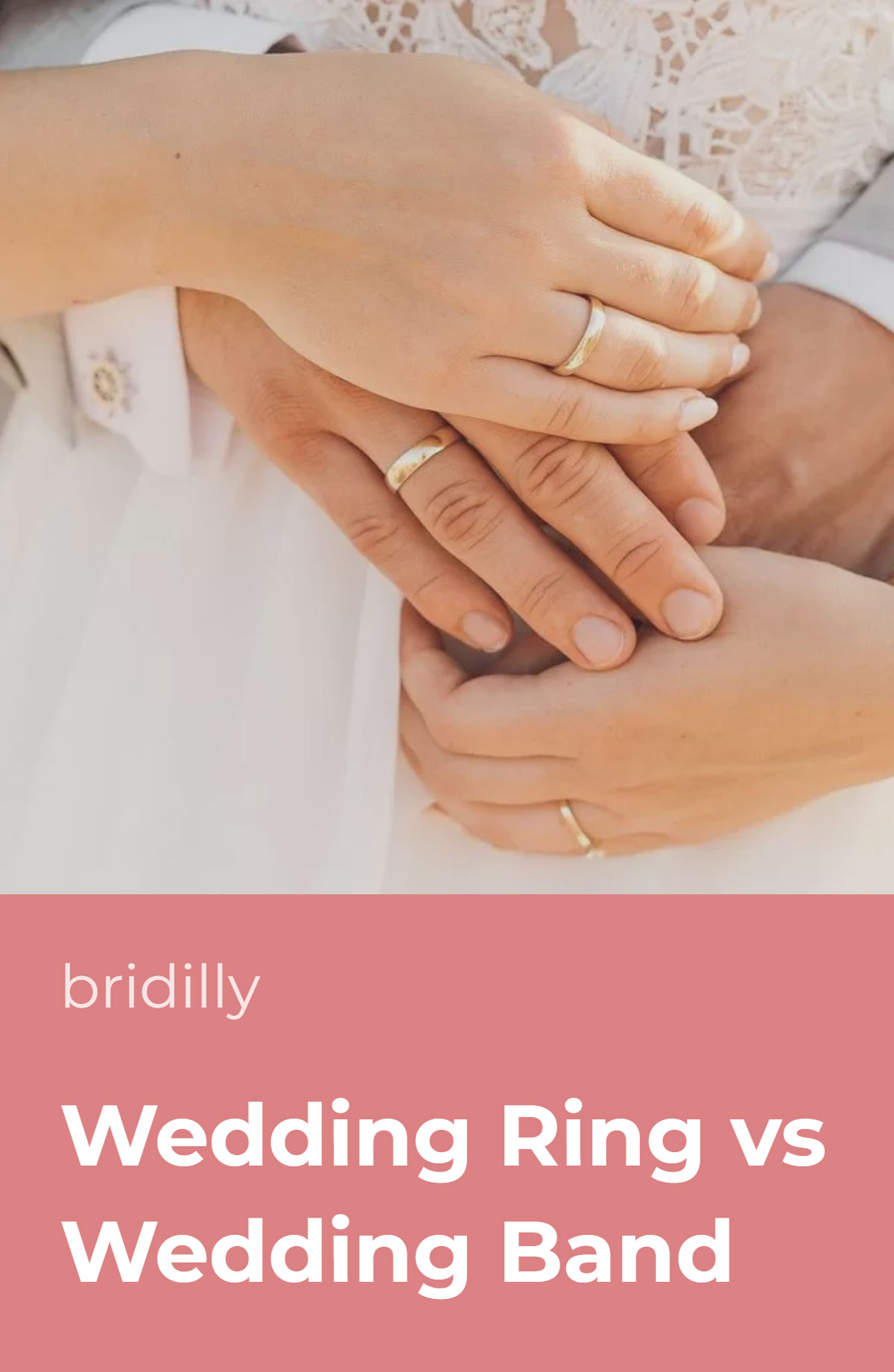Choosing a wedding ring is a complex enough process, and the difference between a wedding ring vs. a wedding band may be somewhat confusing.
You’ve likely heard both terms and are wondering whether there really is a difference.
The short answer is – yes, wedding rings and wedding bands aren’t the same. However, the terms are sometimes used interchangeably.
A common misconception is that a wedding ring is another name for an engagement ring. However, the difference between these types of jewelry is more definite than that between wedding rings and bands.
The truth is, the definition of these terms doesn’t matter much. Most importantly, you should choose a style that speaks to your heart and suits your lifestyle.
Table of Contents [show]
What’s The Difference?
Historically, a wedding band was a simple piece of jewelry with few design intricacies and no gemstones. On the other hand, the term “wedding ring” referred to a more intricate style featuring gemstones.
In other words, the only difference between a wedding band and a wedding ring was the adornment intricacy and presence or lack of gemstones. Nowadays, these terms are often (but not always) used interchangeably.
For instance, if you come into a jewelry store asking for a wedding ring, the sales assistant will likely show you styles with and without gemstones unless you specify your request.
However, if you ask for a wedding band, the sales assistant will most likely only show you simple styles with little to no adornments. They may feature gems, but tiny and not protruding above the surface.
Simply put, every band is a ring, but not every ring is a band. Wedding bands are usually considered unisex, whereas rings are more prevalent among women, though this isn’t a universal rule.
Wedding Ring vs Engagement Ring
An engagement ring is offered during a proposal. It may feature a single large gem, multiple small gems, or none, but engagement rings aren’t usually called engagement bands – confusing, isn’t it?
Traditionally, only the woman wears an engagement ring, but some couples nowadays choose to both wear engagement rings as a sign of mutual devotion.
Wedding rings are exchanged during the marriage ceremony. Women often wear their wedding ring along with the engagement ring, but some only wear the wedding ring or don’t wear any.
Engagement rings tend to be more intricate than wedding rings or bands, as the latter is meant to be worn daily, and engagement rings only until the wedding.
However, it isn’t a law, and you should consider your lifestyle when choosing the ring design.
Wedding Ring Styles
Strictly speaking, wedding ring styles don’t differ from engagement ring styles. When choosing one, you should consider your and your S.O.’s lifestyle, clothing style, preferences, profession, and budget.
Solitaire wedding rings are the most popular style. The word “solitaire” originates from French for “alone,” indicating that such a ring only carries one gem.
Solitaire rings are stunning in their simplicity, are the easiest to resize, and are overall very practical.
Sometimes, rings with a single center stone feature an array of small gems on the band – this style is known as pavé.
Such rings usually cost more and aren’t as comfortable for daily wear as they may catch clothes and scratch skin.
Another traditional wedding ring type is the three-stone style. The name says it all – such rings star three gemstones. The center stone is usually slightly larger and higher set, but sometimes, all the gems are the same.
Three-stone wedding rings are favored by royalty and often feature a combination of diamond and colored gemstones. You may come across other names of this style – trinity or trilogy.
Cathedral wedding rings have a high center stone setting. This style isn’t particularly practical for daily wear, especially if the gemstone has sharp ends.
In halo wedding rings, the center gemstone is surrounded by a “halo” of smaller gems. They emphasize the central stone’s sparkle and make it appear bigger.
Split-shank style wedding rings have a band divided into two or more parts near the center setting – it’s a very modern, unusual style.
Often, wedding rings combine multiple styles. For instance, you may find a halo ring with a split-shank band or a three-stone pave ring.
Wedding Band Styles
While wedding band styles aren’t as diverse as ring styles, there’s still an option for every preference. Classic wedding bands don’t feature any ornaments or gemstones – they have a plain band from gold or platinum.
A classic wedding band can be narrow or wide, flat or rounded, from white, rose, or yellow gold, but most importantly, free from diamonds and adornments.
However, classic wedding bands aren’t necessarily boring. Styles combining two precious metals, featuring engravings or unusual texture, are on the surge.
Consider eternity bands if you’re looking for a more intricate wedding band design.
This timeless, shiny style features a pave of tiny gems along the entire band circumference. Note that full eternity bands are impossible to resize.
On the other hand, half eternity bands only have gems around half of the band and can be resized. Eternity bands can feature different gemstones colors or cuts.
The gemstones in an eternity band can have a prong, channel, pave, or bezel setting. The prong setting is the most versatile, as it accommodates any stone cut. However, gems set in delicate metal prongs are vulnerable to damage.
Eternity bands with prong settings are also the least comfortable for daily wear. The most practical choice is channel or bezel setting, where the stones are mounted deeper and don’t protrude above the setting surface.
Infinity wedding band style resembles the infinity symbol, a sideways eight.
This profoundly symbolic wedding band style comes in various designs: with or without gemstones, narrow or wide, with the infinity symbol around the entire circumference or only in the middle.
Five-stone wedding bands feature five equally-sized stones. This style toes a line between three-stone rings and half eternity bands, but the stones are smaller than in the former case and more prominent than in the latter.
As the name suggests, twisted wedding bands feature two or more narrow metal bands twisted together. Often, the bands are made from different metals, feature stone pave, or intricate engravings.
Perhaps, the most unusual wedding band style is a rolling ring such as Cartier’s famous Trinity ring. The classic Trinity ring style features three bands from white, yellow, and rose gold that are interconnected.
Which Style Should You Choose?
Choosing a wedding ring isn’t a simple task – after all, you’re buying one for a lifetime. To make the right decision, you should first consider whether you’ll be wearing the ring daily.
If your answer is “yes,” choose comfort over the look. Intricate wedding rings with large gemstones are stunning but not too practical, as they may catch clothes and scratch skin.
Furthermore, regular wear may damage the center stone – even if it’s a diamond.
Another factor to consider is whether you’ll wear the wedding ring together with the engagement ring. This point mainly refers to women.
Matching two rings with prominent gemstones is tricky. For instance, a solitaire diamond ring likely won’t look well with a tree-stone diamond and sapphire ring on the same finger. The rings will constantly compete for attention.
Pairing a wedding band with an engagement ring is much easier. Choose a matching metal color and gemstone cuts, while the gemstone type and size may differ.
Alternatively, consider contoured wedding bands that match the shape of your engagement ring.
Then, consider your and your partner’s style, profession, and hobbies. Your wedding bands should express your personality and be appropriate for your lifestyle.
Price Differences
The cost of a wedding ring or band depends on the material, gemstones, style, designer, and location. Classic plain wedding bands are cheaper than full eternity bands or halo rings.
Classic bands cost about $500 on average, depending on the size – larger rings feature more metal and thus cost more. Note that that’s a price of one band, so multiply this figure by two.
Eternity band price differs drastically depending on the gemstone. Diamond full eternity bands range from $1,000 to well over $50,000, while rings with other gems may be more affordable.
Wedding rings usually cost more than classic wedding bands but not eternity bands. The average price of a wedding ring with prominent stone is about $5,000.
Should Your Rings/Bands Match?
Historically, the bride’s and groom’s wedding bands always matched. They may have had slight differences, but the metal color and overall style were traditionally the same to signify the couple’s bond.
Nowadays, many couples choose different wedding rings.
There are valid arguments in favor of such a decision – the partners may have different preferences and lifestyles. Mismatching design doesn’t take away the ring’s sentimental value.
On the other hand, some couples choose the same wedding bands with the only difference being size (and sometimes, even the size is equal).
There’s no rule stating that your wedding rings should match. However, matching wedding bands carry deep sentimental meaning.
If symbolism matters for you, consider matching at least some ring elements while accommodating your preferences and style.
For instance, the bride may have a yellow gold diamond solitaire wedding ring, while the groom a plain yellow gold wedding band.


















No Comments Add one
Leave a Comment